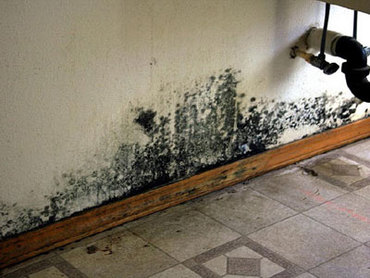Mold Removal Services Eliminate Irritants and Allergens.
Once the mold has been removed from your home or business you will no longer suffer from the health effects which mold causes. Mold can cause nasal stuffiness, eye irritation, wheezing, allergies, or skin irritation. Mold irritants and allergen sensitizers cause mild to severe allergic reactions.
What is Mold?
Mold is a type of fungus with spores and hair-like bodies of individual mold colonies which grow indoors as well as outdoors. There are many different types of mold that will grow all year long in the environments that we provide in our homes. Mold comes in many different colors. The color is determined by the age of the colony and nutrient source the mold feeds on.
Conditions which Promote the Growth of Mold:
Any area that has moisture or is damp and warm for long periods of time will grow mold. Lack of air movement will also promote the growth of mold. Command areas that mold will grow are in: bathrooms; kitchens; crawl spaces; under the structure; and attics. If you have a small water leak with-in the walls which is not noticed for a long time, you could have a large amount of mold growing that you are not even aware of. Behind vinyl wallpaper is an area the mold grows very well in when there is moisture or humidity present.
The more common mold growth areas include:
Four critical tips to keep a home mold-free:
Sometimes unavoidable disasters happen where mold in drywall, attics, basements, or other areas must be removed. On the up side, in day-to-day living, just be aware of conditions that promote mold growth. Keeping an eye out for mold growth will go a long way in helping reduce mold in your home or business.
Warning: Mold penetrates deep into wood fibers and other permeable materials. Mold will not die on its own!
Once the mold has been removed from your home or business you will no longer suffer from the health effects which mold causes. Mold can cause nasal stuffiness, eye irritation, wheezing, allergies, or skin irritation. Mold irritants and allergen sensitizers cause mild to severe allergic reactions.
- Mild Sensitivity to Mold Irritants – People with mild mold sensitivity experience skin irritation, eye irritation, wheezing, or stuffy nasal passages.
- Severe Sensitivity to Mold Allergies – Individuals with severe mold allergies have reactions which include: shortness of breath; fever; coughing and upper respiratory tract symptoms.
What is Mold?
Mold is a type of fungus with spores and hair-like bodies of individual mold colonies which grow indoors as well as outdoors. There are many different types of mold that will grow all year long in the environments that we provide in our homes. Mold comes in many different colors. The color is determined by the age of the colony and nutrient source the mold feeds on.
Conditions which Promote the Growth of Mold:
Any area that has moisture or is damp and warm for long periods of time will grow mold. Lack of air movement will also promote the growth of mold. Command areas that mold will grow are in: bathrooms; kitchens; crawl spaces; under the structure; and attics. If you have a small water leak with-in the walls which is not noticed for a long time, you could have a large amount of mold growing that you are not even aware of. Behind vinyl wallpaper is an area the mold grows very well in when there is moisture or humidity present.
The more common mold growth areas include:
- roofing leaks
- attic condensation
- plumbing leaks
- moisture condensation in unventilated bathrooms
- the crawlspace; and HVAC unit condensation.
Four critical tips to keep a home mold-free:
- Control your indoor humidity to less than 60% maximum. (Recommended range: 30% – 60%)
- Ventilate the rooms in your home
- Immediately remove or replace any soaked carpet or upholstery
- Do not install carpet in a bathroom or basement
Sometimes unavoidable disasters happen where mold in drywall, attics, basements, or other areas must be removed. On the up side, in day-to-day living, just be aware of conditions that promote mold growth. Keeping an eye out for mold growth will go a long way in helping reduce mold in your home or business.
Warning: Mold penetrates deep into wood fibers and other permeable materials. Mold will not die on its own!
Site Design By 3ative Arts - Site Map


